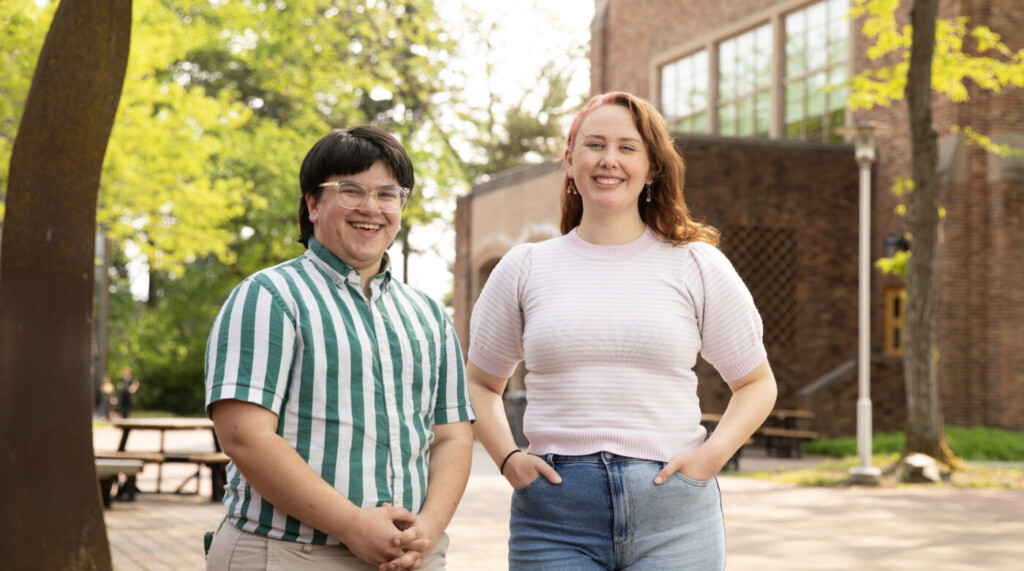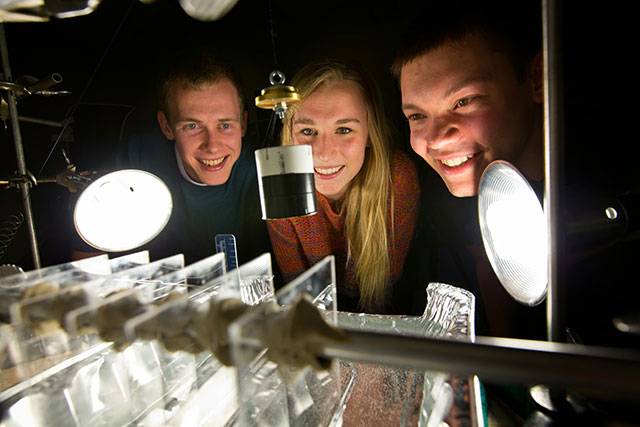Page 35 • (356 results in 0.067 seconds)
-

Together, senior Dylan Ruggeri ’23 and junior Kenzie Knapp ’24 created an innovative climate science musical performance on PLU’s campus in 2022. Both students are majoring in environmental studies and theatre, and the duo drew on their passions to create art, transforming audience perspectives on…
high school graduation. Climate change was one of the most critical issues we could tackle, so I had to commit myself to this work. But I also grew up in the community and high school theatre scenes. Storytelling is such an important aspect of the human experience. I was encouraged to connect the two and have realized that environmentalism, activism and art have historically been interconnected. Climate change involves a lot of data. Numbers and statistics are a lot for folks to digest, but art
-

A pair of nursing students in grey scrubs knock on the door, wash their hands, and greet little Jillian, who rests in a bed connected to beeping monitors. The child opens her eyes and whimpers, then coughs. As the students listen to Jillian’s lung sounds,…
up clinically, including high risk-scenarios that you want a student to be educated in how to handle,” says School of Nursing Dean Barbara Habermann. Research indicates that more higher-level decision-making happens in simulation than in a clinical setting, Kushner says. In a clinical setting, students are often involved in care but are accompanied by a nurse who makes most decisions. In a simulation lab, the students are assessing the situation, interpreting data, and making decisions. Thanks to
-

Together, senior Dylan Ruggeri ’23 and junior Kenzie Knapp ’24 created an innovative climate science musical performance on PLU’s campus in 2022. Both students are majoring in environmental studies and theatre, and the duo drew on their passions to create art, transforming audience perspectives on…
most critical issues we could tackle, so I had to commit myself to this work. But I also grew up in the community and high school theatre scenes. Storytelling is such an important aspect of the human experience. I was encouraged to connect the two and have realized that environmentalism, activism and art have historically been interconnected. Climate change involves a lot of data. Numbers and statistics are a lot for folks to digest, but art, theater, visual and music can help get information
-

TACOMA, WASH. (Sept. 11, 2017)- Kevin O’Brien, dean of the Division of Humanities, acknowledges that programs in his department could be hit hard when Pacific Lutheran University approves final cutbacks in the coming months. Still, he’s as committed as ever to the institution’s mission. On…
day of classes Sept. 5, O’Brien was reminded of the impressive students who attend PLU and the faculty members who teach them to ask tough questions, engage in complexity and exhibit great care for others and the world. “All of that makes me committed to making sure this works out as best it can,” he said. Several weeks ago the Faculty Joint Committee, which convened late last year to review data and propose cutbacks to programs and faculty positions, released its provisional recommendations. The
-

Q&A With Professor Michael Stasinos and Associate Professor Bradford Andrews By Shunying Wang ’15 PLU Marketing & Communications Student Worker TACOMA, WA (Jan. 16, 2015)—In a groundbreaking merger of art and anthropology, Pacific Lutheran University Art Professor Michael Stasinos has been developing important historical illustrations…
be drawing for an archaeological project, students not only have to do research and preliminary studies; they also have to communicate with someone else at stages of its development to show the progress and get feedback and make changes based upon that feedback. I saw it as a great opportunity for students to experience. Instead of having one student doing something for him, I tried to give students the opportunity to build something over time. Andrews: My specialty is stone-tool analysis, so I
-

Mark Lee, Mimi Granlund and Matt Hubbard and the apparatus they built to help them understand how the roughness and size of a tongue would affect the amount of water an animal could lap up and still be efficient. (Photos by John Froschauer) What exactly…
time of her presentation she was waiting nervously to hear whether she would get a job as a data analyst at Seattle-based Horizon Air. She credited this physics capstone – she had to do two others to complete her triple major – with catching the attention of the human resources department at the airline. Every spring, hundreds of PLU students go through the drill of final projects, called capstones. But these research projects, works of art, or music compositions are much more than a final box to
-
Spring, 2022 This issue marks an important transition for the Division of Humanities. As of this summer, the Humanities programs —English, Languages & Literatures, the Language Resource Center, the Master of Fine Arts in Creative Writing, the Parkland Literacy Center, Philosophy, and Religion— will merge…
” of humanities faculty. He argued that these efforts have a significant, lasting impact: These seemingly common tasks reflect our commitment to the challenges of teaching and learning. In calling attention to a twist of phrase, opening up an unknown text, and exploring a new mode of analysis, faculty and students become colleagues in the learning process. When students and faculty work in the disciplines and methods of the Humanities, Peterson suggests, we grow more fully in touch with our own
-

When we first catch up with environmental advocate Andrew Schwartz ‘07, he’s preparing for a massive road trip with his wife, Emily, and 8-month-old daughter, Maja. They’re headed east to visit Emily’s family in Illinois. But the 36-year-old Schwartz’s life has also been a journey,…
After graduating from PLU in 2007, Schwartz held a collection of jobs including working in janitorial services, data entry at a nonprofit, and environmental remediation work on houses. In 2010, he entered Union Theological Seminary, in New York City. He thought he’d become a Lutheran pastor. But by the second week, he wasn’t sure he wanted to stay on. Faculty members encouraged him to stay, advocating for the philosophical and life experiences resulting from seminary school. In 2012, Schwartz was
-

High school choir and guitar teacher Alonso Brizuela ’14 was in Spokane at a national choral directors conference in mid-March of 2020. Just a day and half days into events, the conference shut down early—due to a mysterious new illness that had arrived in the…
before a school parent. It’s very compassionate and student-centered, focused on the families’ needs, versus data-driven. Kids are more than a number on a page,” she says.Lord says PLU’s mission around educating for “a life of service” shaped her perspective during the pandemic. “I think it helped me see where students are coming from before making assumptions,” she says. She can understand and empathize if a student struggles to complete a biology assignment when also experiencing food or housing
-
Global health: Why does it matter? If public health was a fashion show, global health would be the new black. It’s hot. But what is global health, exactly? And why does it matter? Mark Twain once complained that everybody talks about the weather but nobody…
, “global health activities” were responsible for creating nearly 44,000 jobs and generating $4.1 billion in “business activity” in the state. Let’s leave aside for the moment the question of whether we should even be trying to figure out how much money we can make by helping the world’s poorest. Let us just consider how this attempt to quantify global health in terms of the regional economy altered its meaning. The economic impacts were arrived at by virtue of incorporating into the analysis some
Do you have any feedback for us? If so, feel free to use our Feedback Form.


